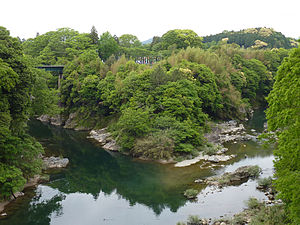- Nagashino Castle
-
Nagashino Castle
長篠城Shinshiro, Aichi Prefecture, Japan 
Site of former Nagashino CastleType flatland-style Japanese castle Coordinates Coordinates: 34°55′22.14″N 137°33′35.45″E / 34.9228167°N 137.5598472°E Built 1508 Built by Suganuma Motonari In use Sengoku period Demolished 1576 Open to
the publicyes Battles/wars Battle of Nagashino (1575) Nagashino Castle (長篠城 Nagashino-jō) was a Sengoku period Japanese castle located in what is now Shinshiro, eastern Aichi Prefecture, Japan. It is noteworthy as the site of the crucial Battle of Nagashino between the combined forces of Tokugawa Ieyasu and Oda Nobunaga against Takeda Katsuyori in 1575.
History
In 1508, Imagawa Ujichika, ruler of Suruga and Totomi Provinces, ordered his vassal Suganuma Motonari to build a castle in Shitara County, Mikawa Province to guard the western approaches to his domains.
The castle came under the control of Tokugawa Ieyasu in 1573, who placed former Takeda vassal Okudaira Nobumasa in control. Following skirmishes with the increasingly bellicose Takeda clan to the north, the castle’s defenses were strengthened. The Takeda invaded Mikawa Province in force in 1575, and laid siege to the castle. In the subsequent Battle of Nagashino, the combined forces of Tokugawa Ieyasu and Oda Nobunaga
Oda Nobunaga and Tokugawa Ieyasu brought a total force of 38,000 men to relieve the siege on the castle by Takeda Katsuyori. Of Takeda's original 15,000 besiegers, only 12,000 faced the Oda-Tokugawa army in this battle. Seeking to protect his arquebusiers from the Takeda cavalry, Nobunaga built a number of wooden stockades, behind which his gunners attacked in volleys. By mid-afternoon on the day of the battle, the Takeda broke and fled, after losing a great number of men, including eight the famous 'Twenty-Four Generals' Katsuyori had inherited from Takeda Shingen. This use of gunfire was a turning point in the history of samurai warfare. After the battle, the castle was allowed to fall into ruin.
The site of former Nagashino Castle was protected as a National Historic Landmark in 1929, the first time a former castle site had received such protection. Located on a fork of two rivers, all that remains of the castle today are remnants of moats and some stonework.
In 2006, the site of Nagashino Castle was listed as No.46 of the 100 Fine Castles of Japan by the Japan Castle Foundation, primarily due to its historical significance. The site is located a short walk from Nagashinojō Station on the Iida Line railway.
References
- Schmorleitz, Morton S. (1974). Castles in Japan. Tokyo: Charles E. Tuttle Co.. pp. 144–145. ISBN 0-8084-1102-4.
- Motoo, Hinago (1986). Japanese Castles. Tokyo: Kodansha. p. 200 pages. ISBN 0-87011-766-1.
- Mitchelhill, Jennifer (2004). Castles of the Samurai: Power and Beauty. Tokyo: Kodansha. p. 112 pages. ISBN 4770029543.
- Turnbull, Stephen (2003). Japanese Castles 1540-1640. Osprey Publishing. p. 64 pages. ISBN 1841764299.
- Turnbull, Stephen (2000). Nagashino 1575: Slaughter at the Barricades. Osprey Publishing. ISBN 18553261911.
External links
Categories:- Castles in Aichi Prefecture
Wikimedia Foundation. 2010.
